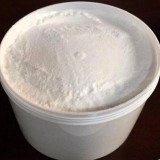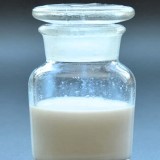 |
Ethylcellulose Dispersion Type B USP NF Grade and Ethylcellulose Powder USP NF Grade Supplier Exporter Manufacturers' Representative |
Email: info@ammol.org |
Call Toll Free +1-855-552-6665 |
Quick Links to Products: Cellulose Acetate | Ethylcellulose Dispersion Type B | Ethyl Gallate | Ethylparaben | Ethyl Oleate | Hydroxyethyl Starches | Methyl Ethyl Ketone Peroxide | Sodium Ethylparaben or Sodium Ethyl p-hydroxybenzoate | and more -- |
Ethylcellulose Powder and Ethylcellulose Dispersion Type B
CAS Number: 9004-57-3


Ethylcellulose Powder and Ethylcellulose Dispersion Type B
Ethylcellulose Dispersion Type B USP NF Grade Specifications:
DEFINITION
A stabilized dispersion of ethylcellulose in water. It contains NLT 90.0% and NMT 110.0% of the labeled amount of Ethylcellulose. It may contain suitable amounts of plasticizers, stabilizers, and glidants.
IDENTIFICATION
A. Film Formation
Analysis: Transfer an appropriate quantity of Ethylcellulose Dispersion Type B to a clear glass plate, distribute evenly, and place in a laboratory oven at about 60C until dry. [Note— It may take less than 60 min.]
Acceptance criteria: A continuous transparent or translucent film is formed.
B. Infrared Absorption
Analysis: Use the film prepared in Identification test A and perform Infrared Absorption.
Standard spectrum: Perform Infrared Absorption using USP Ethylcellulose RS.
Acceptance criteria: The IR absorption spectrum of the film so formed in the 3600–2600 cm-1 and 1500–800 cm-1 regions exhibit maxima corresponding to the same wave numbers as the Standard spectrum.
C. The retention time of the ethylcellulose peak of the Sample solution corresponds to that of the Standard solution, as obtained in the Assay. [Note— Plasticizer and/or stabilizer peaks may be present in the chromatogram.]
Content of Oleic Acid: To pass the test by chromatography.
Content of Dibutyl Sebacate and Oleic Acid: To pass the test by chromatography.
Residue on Ignition: NMT 1.95%.
[Note— Perform this test only if Ethylcellulose Dispersion Type B contains inorganic nonvolatile material.]
Procedure 1: Limit of Glycerin: To pass the test by chromatography.
[Note— Perform this test only if Ethylcellulose Dispersion Type B contains glycerides.]
Procedure 2: Limit of 1-Butanol: To pass the test by chromatography.
[Note— Perform this test only if Ethylcellulose Dispersion Type B contains butyl esters.]
pH: 9.5–11.5
Total Solids: 23.0%–26.0%
Viscosity—Rotational Methods: 400–1500 mPa.s.
Specifications of Ethylcellulose USP NF Grade:
Cellulose, ethyl ether;
Cellulose ethyl ether --- CAS 9004-57-3
DEFINITION
Ethylcellulose is a partly O-ethylated cellulose. It contains NLT 44.0% and NMT 51.0% of ethoxy (– OC2H5 ) groups, calculated on the dried basis.
IDENTIFICATION
A. Infrared Absorption.
ASSAY
To pass the test by chromatography.
Acceptance criteria: 44.0%–51.0% on the dried basis.
Residue on Ignition:
Sample: 1.0 g
Acceptance criteria: NMT 0.5%
Chlorides: To pass the test. ---
Acceptance criteria: After standing for 5 min protected from light, any opalescence in the Sample solution is not more intense than that in the Standard solution (0.1%).
Acetaldehyde: To pass the test. ---
Viscosity—Capillary Methods:
Solution A: Alcohol and toluene (1:4 w/w)
Sample solution: Shake a quantity of Ethylcellulose, equivalent to 5.00 g of the dried substance, with 95 g of Solution A until the substance is dissolved.
Analysis: Determine the viscosity using a capillary viscometer.
Acceptance criteria: The viscosity (mPa·s) determined at 25° is NLT 80.0% and NMT 120.0% of that stated on the label for a nominal viscosity greater than 6 mPa·s; and NLT 75.0% and NMT 140.0% of that stated on the label for a nominal viscosity of NMT 6 mPa·s.
Acidity or Alkalinity:
Solution A: Dissolve 100 mg of phenolphthalein in 80 mL of alcohol, and dilute with water to 100 mL.
Solution B: Dilute 50 mg of methyl red with 1.86 mL of 0.1 N sodium hydroxide and 50 mL of alcohol, and dilute with water to 100 mL.
Sample solution: To 0.5 g of Ethylcellulose add 25 mL of carbon dioxide-free water, and shake for 15 min. Pass through a sintered-glass filter with a maximum diameter of pores between 16 and 40 µm.
Analysis: To 10 mL of Sample solution add 0.1 mL of Solution A and 0.5 mL of 0.01 N sodium hydroxide (Solution C). To 10 mL of Sample solution add 0.1 mL of Solution B and 0.5 mL of 0.01 N hydrochloric acid (Solution D).
Acceptance criteria: Solution C is pink; Solution D is red.
Loss on Drying:
Sample: 1 g
Analysis: Dry at 105C for 2 h.
Acceptance criteria: It loses NMT 3.0% of its weight.
Please visit SDS Safety Data Sheet of Ethylcellulose Dispersion Type B Suppliers.
American Molecules, also known as ammol.org is a distributor, supplier and manufacturers' representative of all types of Pharmaceuticals, Functional Ingredients, Excipients and Specialty Chemicals in Texas USA. Our principals manufacture supply and export USP NF BP, Ph Eur, etc grades of chemicals pure and reagent grade, mineral fortifiers, FCC food grade. Tailor made particle size and customized specifications are offered. The principal's facility is having one or more of the certifications like FDA approval and GLP, cGMP, ISO9001, ISO14001, ISO/IEC 17025, ISO22000, FSSC 22000, ISO45001, FSSAI, Kosher, HALAL, COPP, WHO-GMP certified and Written Confirmation (WC) for export to Europe is available. The manufacturers suppliers and exporters observe WHO Good Manufacturing Practices and Good Laboratory Practices.





Suppliers and Manufacturers' Representative:

9910 Bent Oak Dr
Houston, TX 77040, USA
Call Toll Free: 1-855-55-AMMOL 1-855-552-6665
Email: info@ammol.org